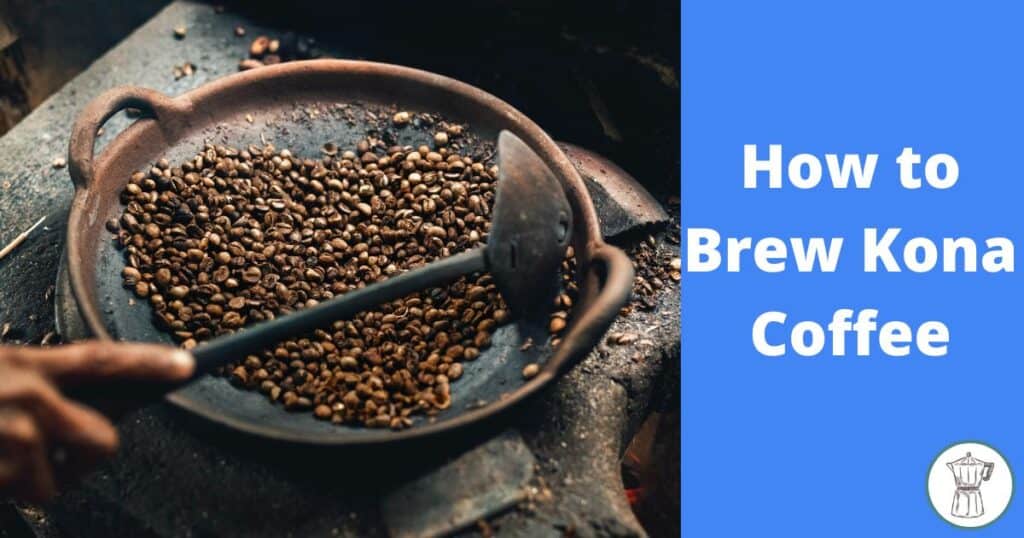Do you know how to brew Kona coffee that tastes delicious?
The other day I came across a coffee that I have never seen before. Kona coffee is not as popular as espresso, cappuccino and latte either. But it’s a delicious coffee you can have in the evening right after work; it’s a real treat. Stick around, I’m going to talk about Kona coffee and reveal all the secrets of how to make a delicious one.
Let’s dive right in.
What you should know about Kona coffee?
Kona coffee is justifiably more expensive coffee than the average type of coffee.
Kona coffee is a special type of coffee cultivated on the slopes of Mauna Loa and Hualalai on the Big Island of Hawaii. The weather on the island is typically described with sunny starts of the day and rainy afternoons. The tropical weather paired with the volcanic soil you’ll find on the island help create this amazing type of coffee that so many coffee lovers around the globe are raving about.
Because of its rich flavour, the fact that only 4,000 acres are planted in Hawaii and the real estate and labour are expensive, the price of Kona coffee is higher than a typical coffee brand.
There are about 600 farms growing Kona coffee and some of them are organic.
How to brew the perfect Kona coffee cup?
There’s no best brewing way for all different kinds of Kona coffee beans.
Depending on the Kona coffee beans that you have there’s a method that suits them best.
I’ll go over all the different methods to ensure you’re covered and are able to brew your beans to extract all the rich flavours and aromas.
Brew Kona coffee with a French press
What’s better than brewing Kona coffee with a French Press? When brewing coffee with a French Press, the coffee is typically very rich in aromas, flavours and oils (and also stronger and slightly higher in cholesterol). If you really want to make the most out of your Kona beans, I’d suggest giving the French press method a go.
Brew Kona coffee with a Pour Over
If you find the coffee made with a French press too heavy, you can always go for a Pour Over that has a filter (whether paper or cloth) attached to filter coffee oils. The Kona coffee that you’re going to make with a Pour Over is still going to taste great and is going to be rich in flavour and aroma. In general, coffee made with a French press is high in cafestol, but there are ways you cant remove it from your brew.
Brew Kona coffee with an Aeropress
Brewing Kona coffee with an Aeropress is the best option if you don’t fancy too rich coffee as the one you make with a French press but richer than the one you make with a Pour Over. It’s the in-between option that makes great coffee.
What’s the best grind size for Kona coffee?
First off, it’s worth mentioning that the best option is to buy whole coffee beans instead of ground beans. Specifically, it’s better for 2 reasons:
- The coffee will be fresher and it will taste better
- You grind the way you like and based on the gadget you’ll use for brewing
Let’s go over all the different grind sizes you need to be aware of.
Coarse grind size
Have you decided to use a French Press for brewing your Kona coffee beans? The best practice is to go for coarse coffee grinds as they’re normally recommended for brewing with a French Press.
Medium grind size
Are you going to use a ‘Pour Over’ gadget for brewing in the end? In this case, the best grind size is medium, it’s highly recommended when brewing with this smart gadget to make the most of your Kona coffee beans.
Medium-fine grind size
Is Aeropress the gadget you’re going to opt for? If so, go for medium-fine grinds to really allow the gadget to extract as much flavour and aroma from your coffee grounds and brew a fantastic cup of coffee.
What’s the best water-to-coffee ratio?
The ratio is 18-1.
So for about 10g of coffee, you’ll need 180 ml of water. In case you can’t measure the water and the coffee you can use this approximation:
For every tablespoon of coffee, you’ll need about a 237 ml (or 8oz) mug of water. This is the best ratio you should go for that doesn’t make your coffee too weak and too strong either.
It’s also equally important to know the right temperature of the water. The range of the water temperature should be:
90.5°C – 96.1°C (or 195-205 ℉).
How to store your Kona coffee beans the right way?
Storage is key if you want your Kona coffee beans to remain fresh and don’t lose their flavours.
When it comes to storing, the best hing to do is keep your beans in the airtight bags they come in that keep the coffee beans fresh for longer; the bags are smart enough to release some of the gas the beans have but block air to come into the bag that could spoil the coffee beans. Once you take out some beans you can use one of those pegs to press the air out. Keep your bag in a room temperature and away from sunlight and moisture.
Top tip: it’s NOT a good idea to keep your beans in the fridge or freezer; you’ll notice a difference in flavour. (But you can keep your brewed hot coffee in the fridge.)
Gadgets that you will need
The gadgets that you’ll need to brew delicious Kona coffee are:
- Coffee bean grinder
- Water filter
- Brewing gadget (French press, Pour Over or Aeropress)
- Scales
When it comes to buying a coffee grinder it’s important to know that there are 2 different types of grinders:
- Burr grinders
- Grinders with a blade
In general, burr grinders do a more precise job with your coffee beans and the grinds they grind are more evenly made. On the other hand, they are slightly more expensive than grinders with a blade – so the choice is yours.
Having a water filter is also vital if you aim to make great Kona coffee. Using tap water for brewing might spoil the taste of your coffee, especially if you live in an area where the water is high in hard minerals.
Let’s wrap it up
Are you ready to treat yourself to a Kona coffee? You now know the recipe and how to make it. You have every good reason to prepare one cup using the tips and tricks we discussed above. You can also learn how to make Cadillac coffee

- How to Remove Coffee Stains From Countertop The Easy Way - December 21, 2023
- Can You Reuse Coffee Grounds in French Press? Truth Inside - December 12, 2023
- Can Expired Coffee Creamer Make You Sick? 3 Ways to Find Out - December 9, 2023
